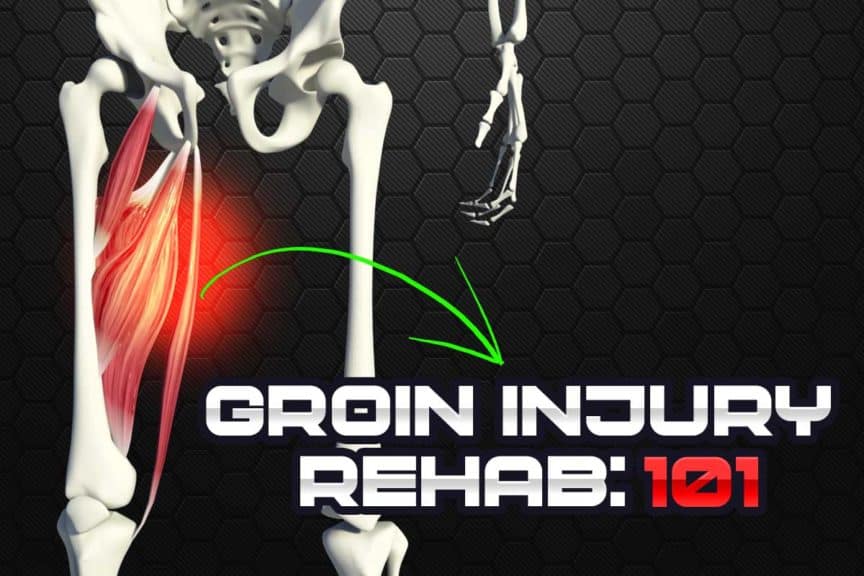Groin injuries are not uncommon, and they can be stubbornly annoying for a variety of reasons. Depending on the severity of the groin pull, they can clear up quite nicely within a week or two or take a few months to really feel like progress is being made. Nonetheless, optimizing the rate and extent of your recovery should be at the top of your priority list.
Recovering from a groin injury starts with basic injury education. It then consists of performing the right amount, type and frequency of groin movements (while avoiding others). It can also involve using therapeutic devices that encourage tissue healing while also keeping the injured area safe.
A groin injury can happen in a variety of ways and to a variety of populations. This particular injury tends to be more common in athletic populations due to the range of motion and forces that they put their groin muscles through. However, it’s still often seen in average, non-athletic populations as well.1,2
To help you save time, you can use the article headlines below to instantly navigate to that section of the article. These are quick links, so simply click (or tap) on the following article headlines to jump to that particular section.
ARTICLE OVERVIEW (Quick Links)
Simply click/tap on the following article headlines to jump to that particular section of the article!
• What is a groin injury
• What are the signs and symptoms of a groin injury
• Grades of groin strains
• Recovering from a groin injury
• Things you need to do
• Things you need to avoid
• Additional ways you can speed up the recovery process
Related article: Do Compression Shorts Help With Groin Injuries? (hint: yes, they do)
Regardless of whether you sustained your groin injury through an athletic event or by some other means, the path to recovery should look relatively similar in terms of the grand overview of the rehabilitative process.
However, the recovery process should always be as individualized as much as possible for each individual, hence the following disclaimer:
Disclaimer: While I am a physical therapist, I am not YOUR physical therapist. As a result, I cannot tell you whether or not any treatments mentioned on this website may or may not be appropriate for you, including groin injury rehabilitation. By following any information within this post, you are doing so at your own risk. You are advised to seek appropriate medical advice for any pain you may be experiencing.
Before diving into the specifics, it would be helpful to quickly discuss what a groin injury is and what exactly is affected within the body when one occurs. This should be very helpful for you to better understand why specific approaches are taken throughout the rehabilitative (recovery) process, which will likely help you to “connect the dots” towards what the big picture is and why certain things need to be done in specific ways.
What is a groin injury (a pulled groin)
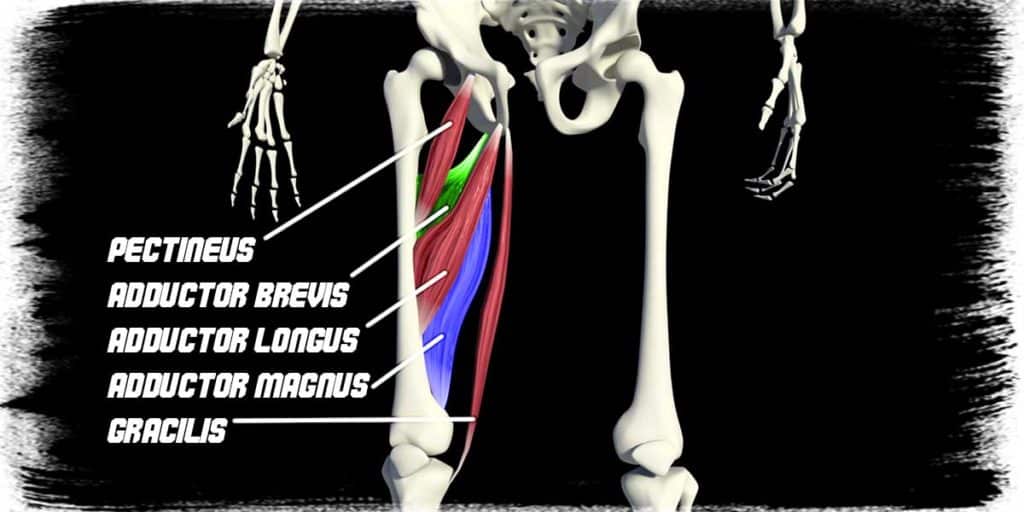
A groin injury (in this case, a groin pull) is a type of injury in which one or more muscles on the inner thigh are overstretched, which is medically termed a “strain.” This muscle strain results from the muscle or its tendon (which attaches a muscle onto a bone) being stretched beyond its tolerable limit, or sometimes from an overly powerful or forceful contraction from said muscle.
The “groin” refers to a group of muscles known as “adductor muscles.” These muscles are primarily responsible for pulling your leg towards the middle of your body. Think of the motion of pulling your legs back together underneath your torso while making a snow angel. That movement of moving the limb back towards the body’s midline is known as “adduction.”
Just for bonus points, the muscles that comprise the adductor muscles are:
- The adductor magnus
- The adductor longus
- The adductor brevis
- The gracilis
- The pectineus.
Muscle strains, be it with the groin muscles or other muscles, can range from relatively minimal tearing of the muscle or tendon to complete tears (a complete tear means the muscle is torn completely in half). The severity is usually graded either as a grade I, grade II or grade III strain, with grade I being minimal and grade III being a full or complete tear.
What are the signs and symptoms of a groin injury
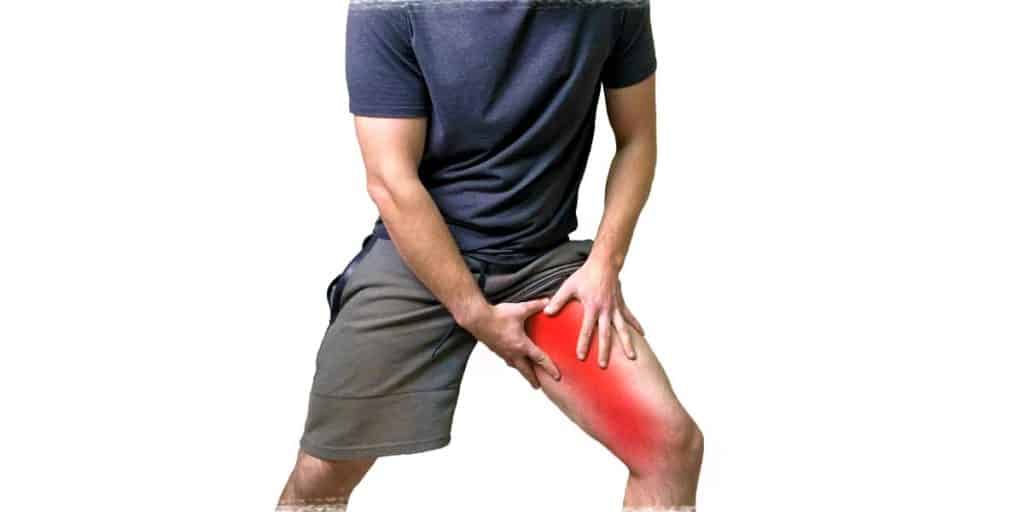
The signs and symptoms of groin injuries can vary a bit, based on the muscle strain’s severity (or grade), which groin muscle has been strained and where it has been strained.
Depending on how the injury occurred, along with the extent of tissue damage, a popping or snapping sensation may be felt anywhere along the inner thigh at the onset of the strain.
Movements that will make the groin feel worse or replicate your current groin pain are likely to be movements in which you actively pull your leg sideways towards the midline of your body.
The more severe the strain, the less resistance the strained muscle(s) can tolerate with this movement before pain is felt.
It likely won’t hurt when moving your leg in the opposite direction (i.e. sideways, away from the midline of your body) until you move the leg out far enough to start stretching or pulling the already strained groin muscle(s).
You may find some other movements to be bothersome, such as:
- Putting your leg straight behind you (think of the position your back leg is in when jogging).
- When actively pulling it back underneath you.
Still, this position and others can vary based on the extent of the muscle strain and which groin muscle(s) have been injured.
Further information about the severity of muscle strains for the groin is described below, based on the grade of strain.
Grades of groin strains (some strains are more severe than others)
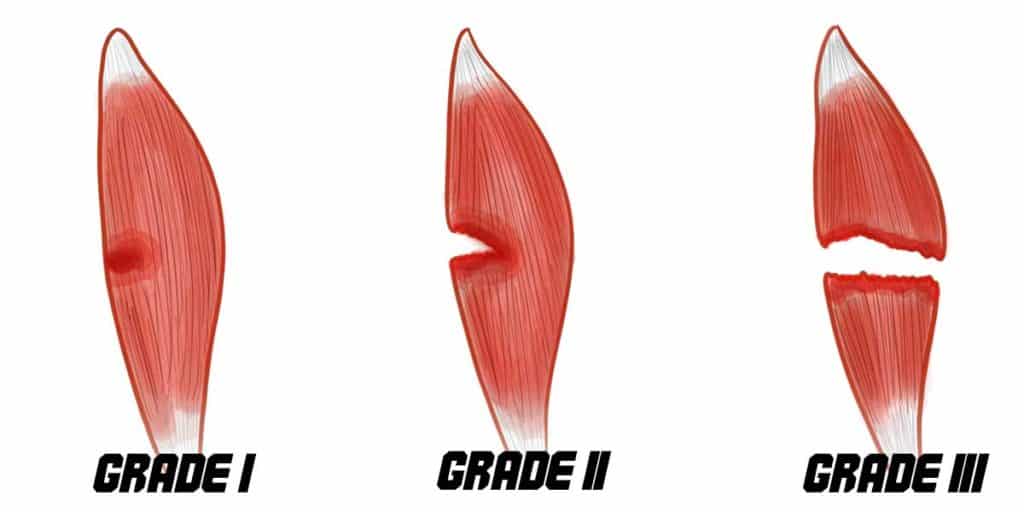
Grade I
A grade I muscle strain of the groin tends to only produce mild pain or discomfort in one or more of the inner thigh/groin muscles when the groin is stretched or challenged with mild to moderate resistance.
- There is typically no popping or snapping heard or felt when the injury occurs, and bruising and/or swelling within the thigh typically are not evident.
- No visible deformity over the affected area is evident with visual inspection.
Grade II
A grade II muscle strain of the groin will produce much more pain and discomfort than a grade I strain. The onset of pain is much more easily provoked when stretching the groin muscles or challenging them with resistance.
- A snap or pop may be perceived when the injury occurs but may not occur or be perceived as well. Bruising and/or swelling may be detectable with observation.
- A visible deformity over the affected area is typically not evident with visual inspection.
Grade III
This grade of muscle strain is a bit rarer for the groin to experience, although it still happens. A grade III muscle strain of the groin will likely produce extreme pain within the initial timeframe for the injury; however, there may be an absence of pain afterward.
This absence of pain is due to the tearing of sensory nerves that arise from the muscle and travel to the brain to inform the brain that there has been trauma. Tearing these sensory nerves is equivalent to cutting the wire that supplies an electric current to a device.
- Popping or snapping sensations are often felt or perceived by the individual when the injury occurs. The individual will likely be unable to use the groin muscles effectively or at all due to the extent of the injury.
- Moderate to extensive bruising will likely be evident, and swelling throughout the affected area may initially be present.
- A visible deformity may be detectable, with either a lump (the portion of muscle that has torn and retracted, pushing the skin above it upwards) being seen underneath the skin or a divot or indentation being spotted where the muscle is absent from beneath the skin.
Related article: How to Prevent a Groin Pull (Complete Step by Step Guide With Photos)
Recovering from a groin injury: the process
When it comes to recovering from a groin injury (in this case, a groin pull), there are a few things that are invaluable to you and will be your best friend throughout the process:
- Education
- Patience
- Confidence with the right movements
- Supportive garments (such as compression shorts)
Patience
Regardless of the severity of the muscle strain any of your groin muscles have incurred, you’ll need to have patience throughout the recovery process; if you try to simply push through the pain, you’ll only make your situation (and pain) worse and prolong your recovery.
Even a grade I strain can take a handful of weeks to show significant improvement. Even then, you’ll want to gradually reintroduce movements and activities to ensure you don’t jump back into things too quickly; performing activities that are too demanding for the recovering muscle(s), even if they’re no longer painful) could risk re-injury.3
Patience will be required, but the good news is that you can significantly speed up the overall recovery process with the right approach.
Getting an evaluation from a qualified healthcare professional
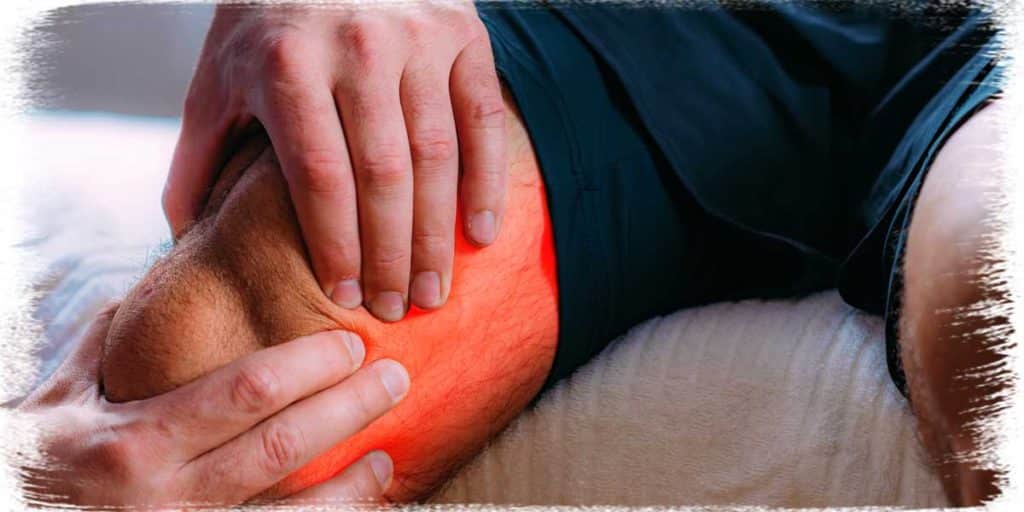
Not everyone has access to or the funds to get a professional evaluation and subsequent treatment from a qualified health care professional, such as a licensed physical therapist. Still, if you can, it will very likely help to a great extent.
This is because your treatment can be custom-tailored to your injury and that your therapist can use pain-relieving modalities, therapeutic treatment techniques, and most importantly: provide you with education to help arm you with confidence for the rehabilitative process ahead.
If you can’t afford multiple treatments, even springing for just an evaluation can provide you with a great base of knowledge for the extent and nature of your injury. It can also give you confidence with how to start tackling/rehabilitating it specifically to your needs.
So, if the pain from your groin pull hasn’t drastically subsided or gone away within the first week or so, an evaluation may be a great idea.
Things you need to do
For the first one to three days (24 – 72 hours), you can follow the RICE (rest, ice, compression, elevation) protocol. It’s certainly not a bad thing to do, but you’ll likely want to move away from it after the two or three-day mark.4
After the first few days, you’ll likely benefit from starting to do gentle, pain-free movements with your leg, no matter how small or gentle the movement is. Laying on your back while doing this is often an excellent way to start since your leg isn’t in a gravity-loaded position.3
Play around with movements, again, no matter how small or gentle. As long as it’s pain-free, it will likely be beneficial. Pain-free movements will help the muscle to stay active while pumping blood into and out of the area. 3
As long as it doesn’t hurt during or after the movement, do it again a few hours later on in the day. A handful of times each day will start to build momentum in the recovery process.
This is the general process you’ll need to follow until you can perform some very gentle resistance exercises for the muscles — this tends to be appropriate after about a week (though this depends on a multitude of individual factors).
As this process and time both continue, your pain-free range of motion will likely keep improving, and your ability to perform more and more resistance with specific movements will likely do so as well. These will be very gradual improvements that take time, but it will be rewarding to see (and fee) the progress.
Once you can get back to performing all your activities of daily living (walking, climbing stairs, etc.) without any pain, then you’ll likely feel that the recovery process will start to really accelerate from thereon.
Things you need to avoid
Just as it is important to know what’s appropriate to do to heal a pulled groin, you also need to know what’s NOT appropriate to do.
I certainly can’t cover everything here or get overly specific in a simple blog post, but here are the things you’ll want to likely avoid:
Avoid static stretching like the plague. Static stretching is the type of stretching that most people are familiar with, you know, the type where you hold a muscle in a stretched position for 30 seconds or a minute.
Avoid this like the plague because the affected muscle(s) are in a spasm-like state as a means to further protect themselves from further stretching — remember, a muscle strain is the result of a muscle or tendon being overstretched.
You aren’t doing yourself any favours or physical benefits of stretching the muscle like this, especially when the injury is fairly new.
You would also be wise to avoid any movements that make your pain worse. This may sound obvious, however, some people believe they are helping the situation by strengthening the affected muscles when the muscles are nowhere near ready for this. The strength rehabilitation will come in a later stage once the pain subsides to a certain extent and the functional ability of your groin muscle(s) begins to improve as well.
And, in case it isn’t evident by now, you need to avoid NOT moving. Your strained muscles won’t heal nearly a quickly nor as effectively if you try to keep it still for weeks on end. Movement is medicine, so long as you dose it correctly with the right type, right amount and correct frequency.3
Additional ways you can speed up the recovery process
Knowing what you need to do more of, less of, and how to not overdo it along the way is the critical first step to take. Still, there are also some great additional adjuncts that you can also implement as a means to potentially further augment the rate and extent of the recovery process.
These are not magic bullets by any means, but they might just help take the edge off that much more quickly and give you added comfort while creating a healthier environment for nursed tissues. Here’s a quick rundown on a few of those things:
Use compression shorts during activities and throughout the day
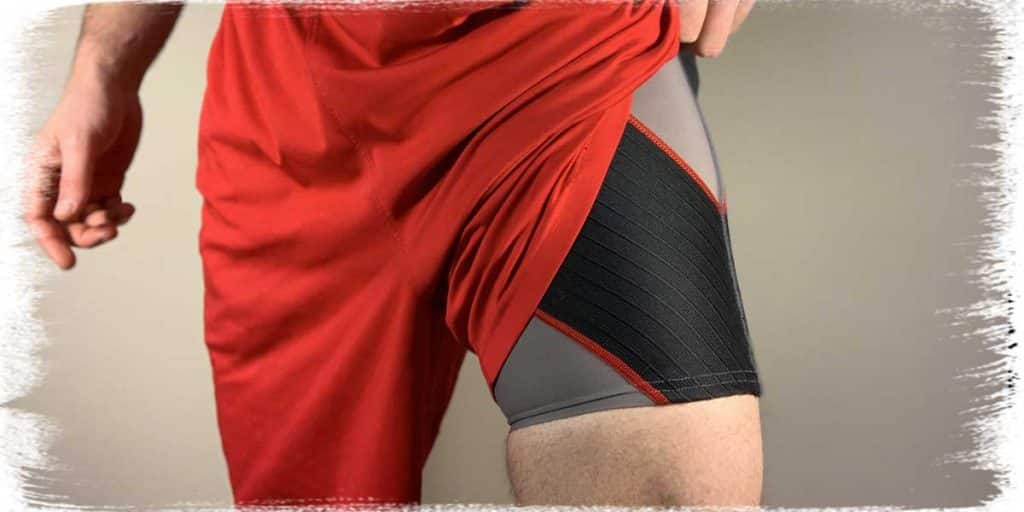
For a complete rundown on what compression shorts are, how they can help and how to pick out the right type for yourself, be sure to check out my blog post: Do Compression Shorts Help With Groin Injuries?, where I break down all you’ll want to know as to how compression shorts can help and what the science is finding with their ability to expedite recovery from a groin pull.
In short, compression shorts will help in a few key ways, primarily through helping to offload the work required of the groin muscles while also helping them to stay a bit more within pain-free ranges (i.e. making it a bit harder to move your groin into stretched-out positions that may be irritating or painful).5
Make a hip spica with a wide tensor bandage
If compression shorts aren’t your thing, or you don’t want to spend the money on a pair, you could opt for a very similar (and perhaps just as effective) option using a tensor bandage. So, if you have a wide (6″ tensor bandage available, or don’t mind dropping a few bucks to get one), you can essentially do the same thing. It’s not as glamorous looking, but functionally it will likely be just as helpful.
The hip spica will provide gentle compression around the groin while also restricting it from more extensive ranges of motion of the hip, which could irritate the strained muscles, causing more pain and potential setback to injury recovery.
Check out the following video on how to create a hip spica!
Use gentle, soft tissue massage from a variety of tools
There are numerous ways that you can gently massage and rub the affected muscle(s) along with the rest of the inner thigh to help muscles relax while simultaneously enhancing blood flow within the area.
The type, extent and pressure of massage will depend on numerous factors pertaining to the extent of your injury. This includes where you are along the recovery timeline and other personal factors, but the following techniques can be quite therapeutic under the right circumstances:
Dynamic cupping techniques
Cupping is a unique therapeutic treatment that can really help enhance blood flow to the targeted area. It can be used for other reasons as well. In the case of dealing with a groin pull, it can work great by creating a negative pressure gradient (a vacuum effect) under the skin, causing blood to rush into the area.
The enhanced blood flow may create a more optimal healing environment for the strained tissue, and the stimulation of the skin on the inner thigh from the cup can also have a transient pain-relieving effect.
If you’re going to spring for some cups, silicone ones work best for dynamic gliding. Just put some lotion on your skin and you should be good to go. I have a set of Elera cups (Amazon link) that I use on myself that I’ve been quite happy with. They don’t cost much and hold up really well (we also use the same type in our clinic where I work). They’re tolerated quite well by my patients and provide ample amounts of suction for desired needs.
Disclosure: I have an affiliation with Amazon, which earns me a small commission when you purchase through any links (at no extra cost to you). I use these small commissions to offset the expenses I incur with running this website.
Therapeutic massage devices
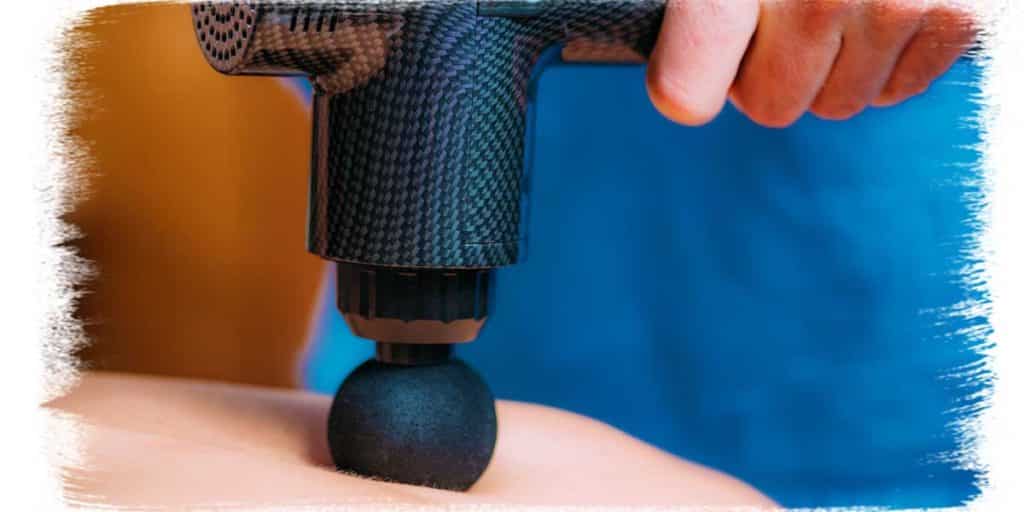
There’s nothing wrong with using your hands when it comes to providing some soft tissue massage for your groin. In fact, in the early stages of the injury, your hands will likely be the most appropriate way to gently massage the affected groin/inner thigh.
The groin lends itself quite well to treatment from your own hands in terms of its location and ease to place your hands on.
But when the tissues are healthy enough to tolerate more pressure or longer durations of massage, your hands might get tired, especially when regularly doing these sorts of self-massages.
A therapeutic massage device can come in handy at this point, and there are certainly many different types. Massage guns tend to be quite nice for these occasions, though not necessary. They can relieve your hands from duty and do a great job enhancing local blood flow to the targeted area.
If you ARE looking for a massage gun that hits the sweet spot between price and performance ratio, I’ve been recommending the Mebak 3 (Amazon link) for some time now. I use the Opove M3 pro, and have been very happy with it, but it’s no longer on Amazon. However, the Mebak 3 has thousands of great reviews, so that would likely be my next option if I were to purchase another one.
TENS unit for pain relief
A Transcutaneous Electrical Nerve Stimulation (TENS) unit won’t really do anything to augment the recovery process, per se. Still, it can be a great option when you just need to block out some pain for the time being.
That’s precisely what a TENS unit does; it provides a gentle, buzzing or tingling sensation on your skin, which is detected by the sensory nerves within your skin. Your brain picks up on this sensation and fixates on it rather than fixating on the pain coming from your strained muscle(s). The result is a temporary reduction in the sensation of pain.
You’ll need to make sure that a TENS unit is appropriate for you, but if it is, they are straightforward to use and are inexpensive to purchase. It certainly beats the alternative of swallowing pain meds and risking side effects to your gastrointestinal system or other medicine-related side effects.
I recently ordered the Belifu Dual Channel TENS unit (link to Amazon) and have been rather pleased with it. It’s sleek looking, small and rechargeable via USB. It’s got a variety of great features but is easy to use. So if you’re looking for a solid, basic little unit that won’t break the bank, that’s my personal recommendation.
Final thoughts
Groin injuries suck, but when you have a better understanding of the structures that have been affected, what to do, what not to do and how to help the affected tissues have the most effective recovery environment possible, you can indeed speed up the process and get back to feeling better much more quickly than when compared to trying to recover without any movement at all.
Remember, be patient. Injuries are never fun, but they’re even worse when you run out of patience, push things too quickly and only wind up setting yourself back even further as a result. You’ll get through this. Be smart, be patient, and try your best to look at this as a learning opportunity from which you will emerge both mentally and physically stronger.
References:
2. Nicholas SJ, Tyler TF. Adductor muscle strains in sport. Sports Med. 2002;32(5):339-344.
3. Quinn A. Hip and groin pain: physiotherapy and rehabilitation issues. Open Sports Med J. 2010;4(1).

Hi! I’m Jim Wittstrom, PT, DPT, CSCS, Pn1.
I am a physical therapist who is passionate about all things pertaining to strength & conditioning, human movement, injury prevention and rehabilitation. I created StrengthResurgence.com in order to help others become stronger and healthier. I also love helping aspiring students and therapists fulfill their dreams of becoming successful in school and within their clinical PT practice. Thanks for checking out my site!

